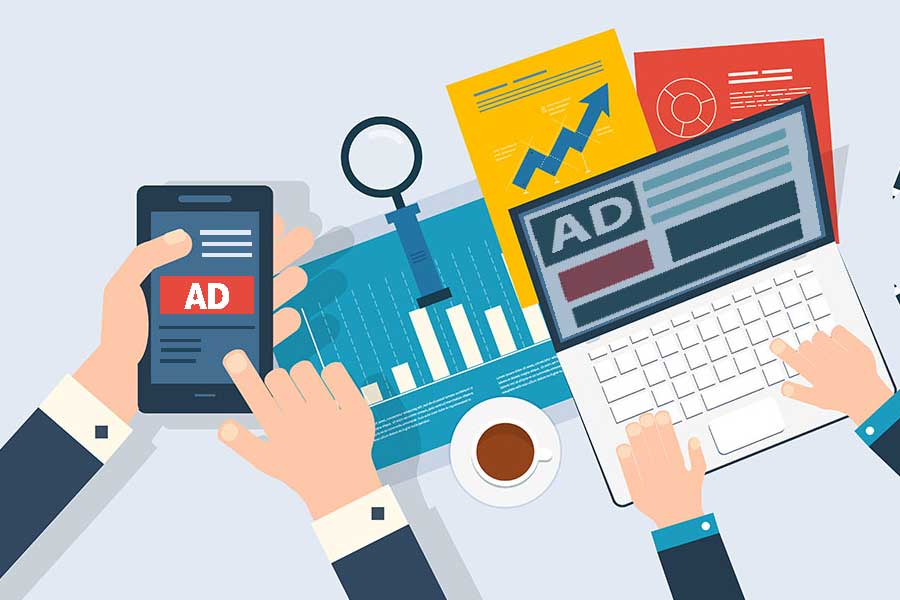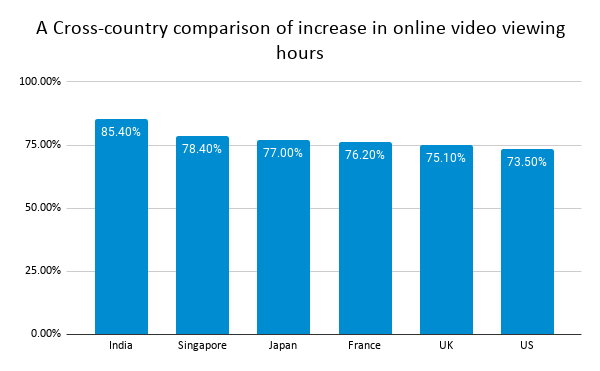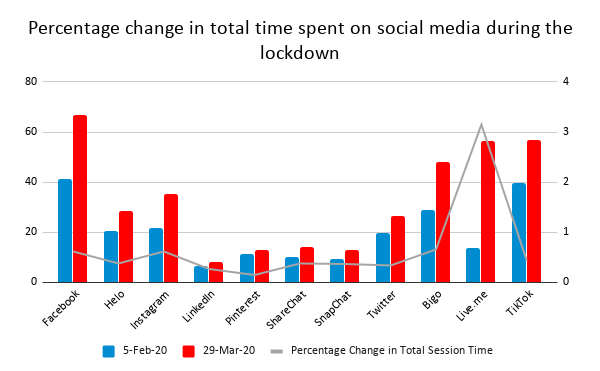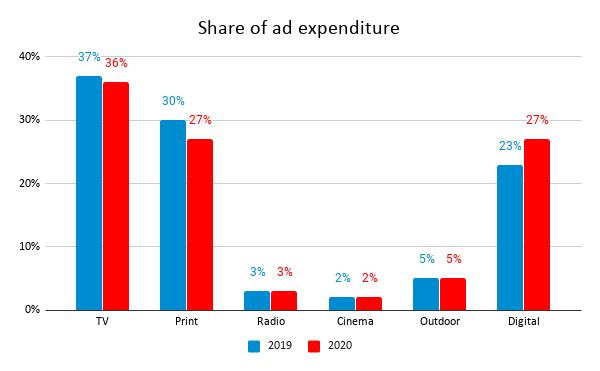Advertising your way through COVID times
• With employees working from home and many industries pausing operations, market sustainability of numerous brands was put to a test during the lockdown.
• The advertising industry, too, witnessed many changes: while there was a significant drop in ad expenditure of brands, there was an expansion in ad space, with appetite for digital platform growing among advertisers.
• Now that the pandemic has transformed the media consumption habits of the public, experts believe that there would be a continued increase in thrust on digital media.
• They are also hopeful that with the festive season around the corner, there is likely to be a demand for products. Therefore, the second half of the year offers a ray of hope to the advertising industry in India to bounce back on its feet.

If there is one apt phrase to describe 2020, it is “testing times” – be it for the virus itself or for the cataclysmic business disruption it unleashed. As the scientific community goes on overdrive, experimenting on the magical vaccine that will render COVID-19 harmless, it has equally been a time for businesses to go on experimental mode. Be it the rise of telemedicine, neobanking, PPE kit and sanitiser manufacturing, webinars, home schooling or remote working, 2020 saw countless bold experiments taking off. And the advertising industry is no exception.
With employees working from home and most industries pausing operations at the onset of COVID-19, advertising businesses automatically saw their revenue streams under stress. As people spent their days within the safe confines of their homes, TV shoots came to a sudden halt (except for news channels) and there was a surge in online content consumption. A survey by global search engine Google – What is India searching for? Insights for brands – points out that search interest for overall video streaming platforms surged between 40% & 120% as Indians clocked almost four hours per week per person on video on demand. The study states:
In a country like India with over half a billion netizens and one of the world’s youngest internet populations, digital has become the source of an endless stream of information as Indians decide what to watch, read, learn, and buy. Whether it’s looking for essentials, managing routines when homebound, or even keeping up to date with the news and entertainment, digital dependence has seen a significant increase.

Source: Limelight Networks; figures are for April-May 2020

Source: Kalagato; figures represent session time in minutes
Similar observations are made by other studies. According to a global survey by Limelight Networks, the rise in online video viewing hours was also the highest in India at 85.4%. Likewise, a report by KalaGato, a big-data intelligence & audience insights platform reveal that lockdown led to a spike in the time spent on social media platforms.
This period proved to be the golden period for OTTs and gaming platforms or any company/service wanting to increase its user base in the nation. Leveraging this opportunity, a lot of brands decided to shift sails to leverage these winds of change and started promoting their products online. The advertising space saw opportunity for an explosive growth in digital content consumption (esp. on social media, OTT and gaming). Taking into account the dramatic change in which we consume media in the midst of these tough times, marketers began understanding the need for a paradigm shift in strategy. The need for allocating budget to digital ads and promotions became the go-to business strategy for some brands.
Paid search is emerging as a cost-effective and flexible marketing option as it offers businesses the ability to adjust campaigns as and when needed. Ideal for volatile market situations, it enables companies to track the conversion, level of engagement, click-through rate and track the ROI of a campaign to make adjustments.
A case in point is Panasonic, which recently launched a digital campaign for ‘Parents Day’. The campaign proved to be a correct one as it helped them in bringing favourable returns. Prashant Verma, Head of Marketing, Grofers notes, “Post-COVID, we have seen an increase in digital media consumption (across video, music and other e-content) and it has now taken a central role in our media mix with a 70% share for brand marketing today. Within digital, leading OTTs and shorter brand films on YouTube and Facebook have served us well and this trend will continue for rest of the year.”
At the same time, the coronavirus pandemic caused a considerable drop in global advertising spending. The World Economic Forum observes that ad spends are down by 9% on an average across Europe, with Germany and France falling by 7% and 12% respectively. The same holds true in the Indian context. As per a report by the Interactive Advertising Bureau, “almost 24% media buyers, planners and brands paused ad spending till Q2, while 46% indicated they would adjust their ad spending across the same period”.

Source: Pitch Madison Advertising Report, 2020
The Pitch Madison Advertising Report, 2020 predicted a muted growth of 10.4% in ad expenditure (AdEx) earlier this year. In its mid-year review of advertising spends in India, the company noted that AdEx saw a dramatic decline of 39% in the first half of 2020 & a whopping 65% for Q2, shaving off almost Rs 14,000 crore from the ad pie. Traditional media saw 47% de-growth in H1 and 71% in Q2. The pandemic negated money-generators like the IPL from the April-May-June quarter this year, which has added to the decline.
The firm estimates that H2 2020 seems to hold brighter prospects as TV and digital seem to be inching towards normalcy. The launch of IPL and big ticket properties such as KBC and Bigg Boss, coupled with the onset of the festive season are likely to help the industry bounce back.
What does Unlock hold for Indian advertising industry?
Year 2020 has changed things for marketers and brands, forcing them to come up with new marketing solutions as the consumption of media and entertainment changed. The brands that were ‘traditional marketing’ oriented have embraced digital marketing with an impressive zeal. As the markets unlock and conventional modes of advertising begin to make a comeback, one thing is for sure that digital is the way ahead – whether marketing or mode of work.
Sanjay Mehta, Joint CEO, Mirum India says:
“The economic challenges of the current period do force brands to think sharper on ROI factors, where marketing spends are concerned. Hence digital as a highly measurable medium, becomes a first call. Even within digital, data-driven marketing and marketing automation become a must-do, since these generate even sharper focus and enable far better ROI on spends.”
Given that digital marketing is an unexplored gold mine for advertising right now, an important question that arises is how brands should harness this technology to maximise their ROI. Data-driven marketing, which lies at the heart of this form of marketing, is an effective channel to track the percentage rate of incoming traffic gets converted into leads, subscribers or sales. Therefore, brands must do a thorough research pertaining to the composition of their target audience such as age, income, gender, geographical location and so forth.
Brands must also remember the fundamental principle of advertising: content is the king. Content marketing is important because it informs, entertains, educates and offers utility to the consumers about the product. This is important because customers expect brands to communicate around the company’s purpose and values. Gravitating to content, which centers on empathetic communication to connect with consumers on a deeper level will be crucial in these testing times.
Lastly, marketers can also experiment with different campaigns. A/B testing – where a firm runs two different, yet similar, ads or campaigns to see which gets the best results – is a great way to compare how two different campaigns can gather results. This can help the brands understand which one resonates the best with their audience. They must also track their key performance indicators (KPIs). Implementing comprehensive analytics can allow brands track conversions and understand where individuals may be choosing to drop out of their marketing funnel.













Leave a comment